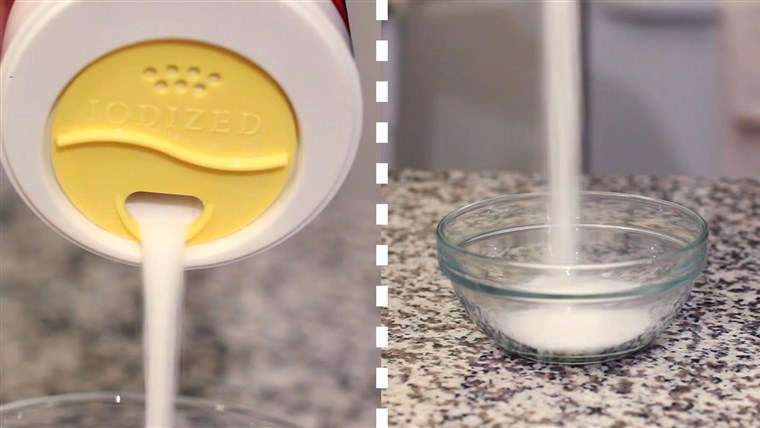Back in 1992, the National Institutes of Health funded research to see if changing people’s diets could help lower their blood pressure. They discovered that by choosing the right foods, people could lower systolic blood pressure (the first number) by 6 to 11 mmHg.
Healthy blood pressure levels are important. “High blood pressure puts you at risk for other conditions like stroke and heart disease,” Karen Ansel, a New York-based registered dietitian and author of “Healing Superfoods for Anti-Aging,” told TODAY.
What does the DASH diet stand for? The DASH diet stands for Dietary Approaches to Stop Hypertension. And as it turns out, the DASH diet brings other health benefits, too. It can help prevent osteoporosis, cancer, diabetes, kidney stones and depression.
What is the DASH diet? It’s a plant-focused eating plan — think fruits and veggies, low-fat and non-fat dairy, lean meats, fish, poultry, whole grains and heart-healthy fats. It limits red meat, salt, added sugars and fat.
How does the DASH diet work?
The typical American diet is high in processed foods, which are generally high in sodium. The DASH diet replaces processed foods with healthy, whole foods so sodium levels come down.
And it emphasizes high-calcium, high-potassium foods that help bring blood pressure down. “It’s high in the nutrients that support healthy blood pressure levels,” Samantha Cassetty, a registered dietitian based in New York City and the coauthor of “Sugar Shock,” told TODAY.
To eat in line with the DASH diet, you start with your daily calorie requirement. That number comes from your age, activity level and weight loss goals. Then, you eat servings from a range of food groups every day to meet that calorie target.
“This diet has more statistical evidence behind it than any other diet,” Ansel said. “There are dozens of studies showing what it can do for your health. There’s a lot of science behind it.”
The diet can:
- Lower your blood pressure. Five studies funded by the National Heart, Lung, and Blood Institute found that the DASH diet lowered blood pressure and bad cholesterol.
- Reduce your heart failure risk. A 13-year study found the DASH diet lowered risk of heart failure.
- Cut your risk of diabetes. A study of more than 40,000 men found the DASH diet helped reduce diabetes risk.
- Help you maintain your weight. A 30-month study found that people who lost weight were more able to keep it off with the DASH diet.
- Reduce your risk of heart disease and stroke. A 24-year study found the DASH diet reduced risk of heart disease and stroke in women.
Is the DASH diet a good choice for you?
What are the DASH diet pros and cons? The DASH diet is a healthy eating plan for a lot of people. It’s a top choice for people who want to lower their blood pressure or reduce their risk of heart attack.
Two to three servings of dairy foods are built into the DASH diet menu plan, so it’s not a great choice for vegans, people who don’t like dairy, or people who avoid dairy foods for environmental reasons.
If you’re used to eating a lot of processed food or fast food, you may want to transition to the DASH diet gradually. “If you’re not used to fiber — if you don’t eat a lot of fruit, vegetables, beans and whole grains — you’re probably going to be pretty uncomfortable. Start slowly and give your digestive system and gut bacteria time to acclimate,” Ansel said.
With the DASH diet for beginners, you can start by adding more vegetables, switching to low-fat dairy foods and cutting back on meat.
The diet focuses on servings, so you’ll need to pay attention to serving sizes and keep track of what you’re eating, at least until you get accustomed to the plan. “If you want to follow it to a T, you have to stay on top of it,” Cassetty said. “Over time these things become more natural.”
This diet may not be appropriate for people with advanced kidney disease, according to Ansel, so those people should consult with their doctor before trying DASH.
What do you eat on the DASH diet?
With the DASH diet, what you eat is based on how many calories you should take in. According to the Mayo Clinic, for 2,000 calories a day, your DASH diet food list might include:
- 6 to 8 servings of grains, mostly whole grains
- 4 to 5 servings of vegetables
- 4 to 5 servings of fruit
- 2 to 3 servings of dairy
- 2 to 3 servings of fats and oils
- Up to 1 serving of lean meat, poultry or fish
- 4 to 5 servings a week of nuts, seeds and legumes
- Up to 5 servings of sweets a week
- No more than 1 alcoholic drink a day for women or 2 for men
What is not allowed on the DASH diet? It limits processed foods, fat, meat, added sugar, alcohol and sodium.
Sodium plays a big role in blood pressure control. So, there are two versions of the DASH diet. The standard version allows for up to 2,300 mg of sodium a day. The lower-sodium version limits it to 1,500 mg a day.
In a typical day, you might eat:
- Breakfast: Unsweetened oatmeal made with low-fat milk, nuts and fruit
- Lunch: Chilled tuna pasta salad made with broccoli, tomatoes, feta cheese and whole wheat pasta, plus a side of berries.
- Dinner: Grilled shrimp served with whole-wheat couscous, roasted cauliflower and a side salad
- Snack: 1 medium apple and a cappuccino (decaf if you prefer)
Dashdiet.org offers more DASH diet meal plans and DASH diet recipes.
Can you lose weight on the DASH diet? The diet isn’t designed for weight loss, but by following it you can make healthier food choices. To follow the DASH diet for weight loss, you may need to limit your total calories.
The DASH diet is similar to:
- Mediterranean diet, a plant-heavy diet that reflects the food choices of the cultures that surround the Mediterranean Sea
- MIND diet, a blend of the DASH diet and the Mediterranean diet, designed to promote brain health
- Flexitarian diet, a mostly vegetarian diet that permits some animal protein
- Mayo Clinic diet, which promotes weight loss and maintenance
Is the DASH diet effective long-term?
“It’s a really great pattern of eating and there are lots of foods to choose from. You could follow it for a long time,” Ansel said.
It’s proven to help lower blood pressure over the long term. It may also help prevent heart disease, stroke, cancer, diabetes and osteoporosis. It could help you maintain a healthy weight over time.
Talk with your doctor before starting the DASH diet or any other diet — your doctor can recommend the best eating plan for you, based on your health needs.



